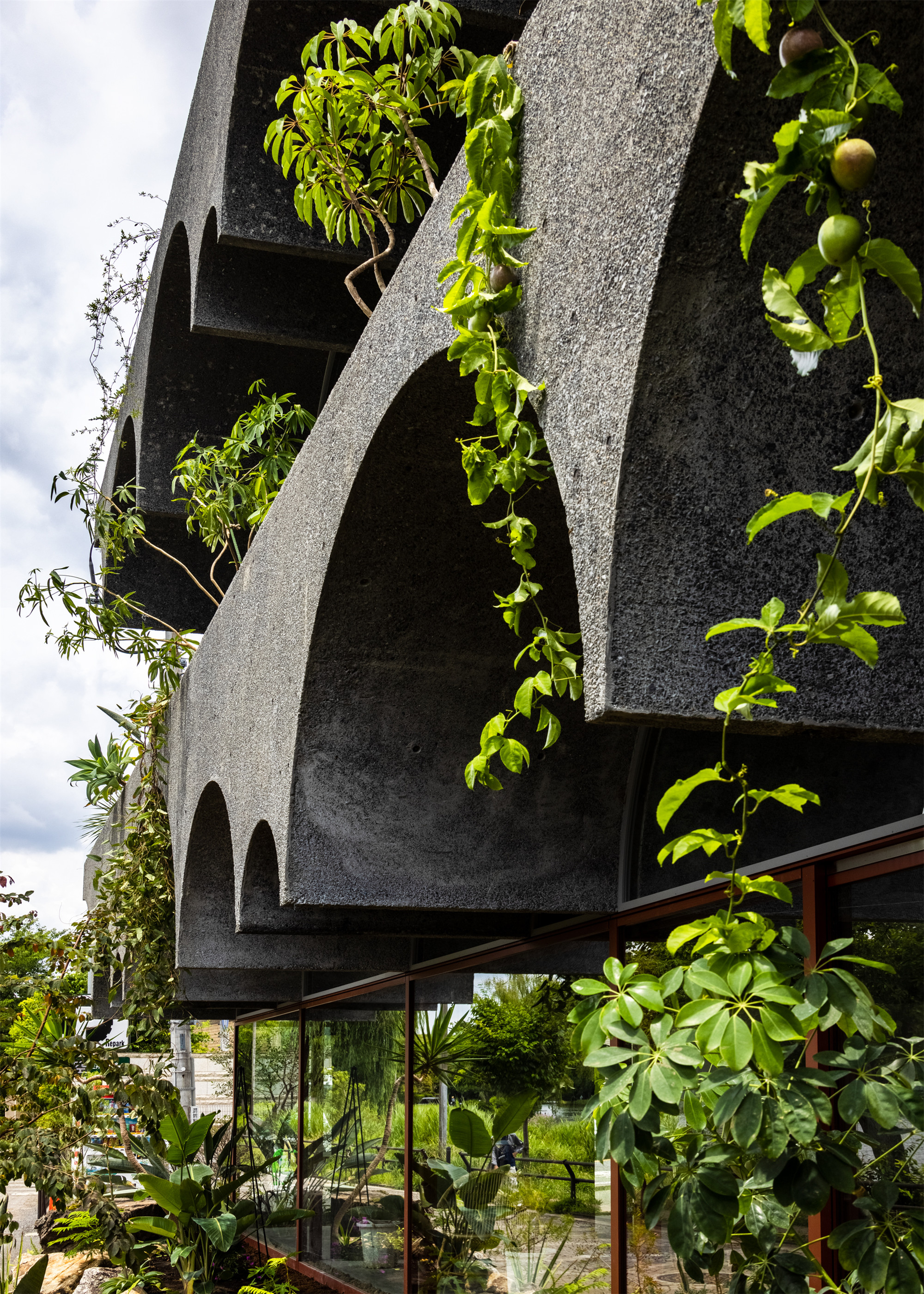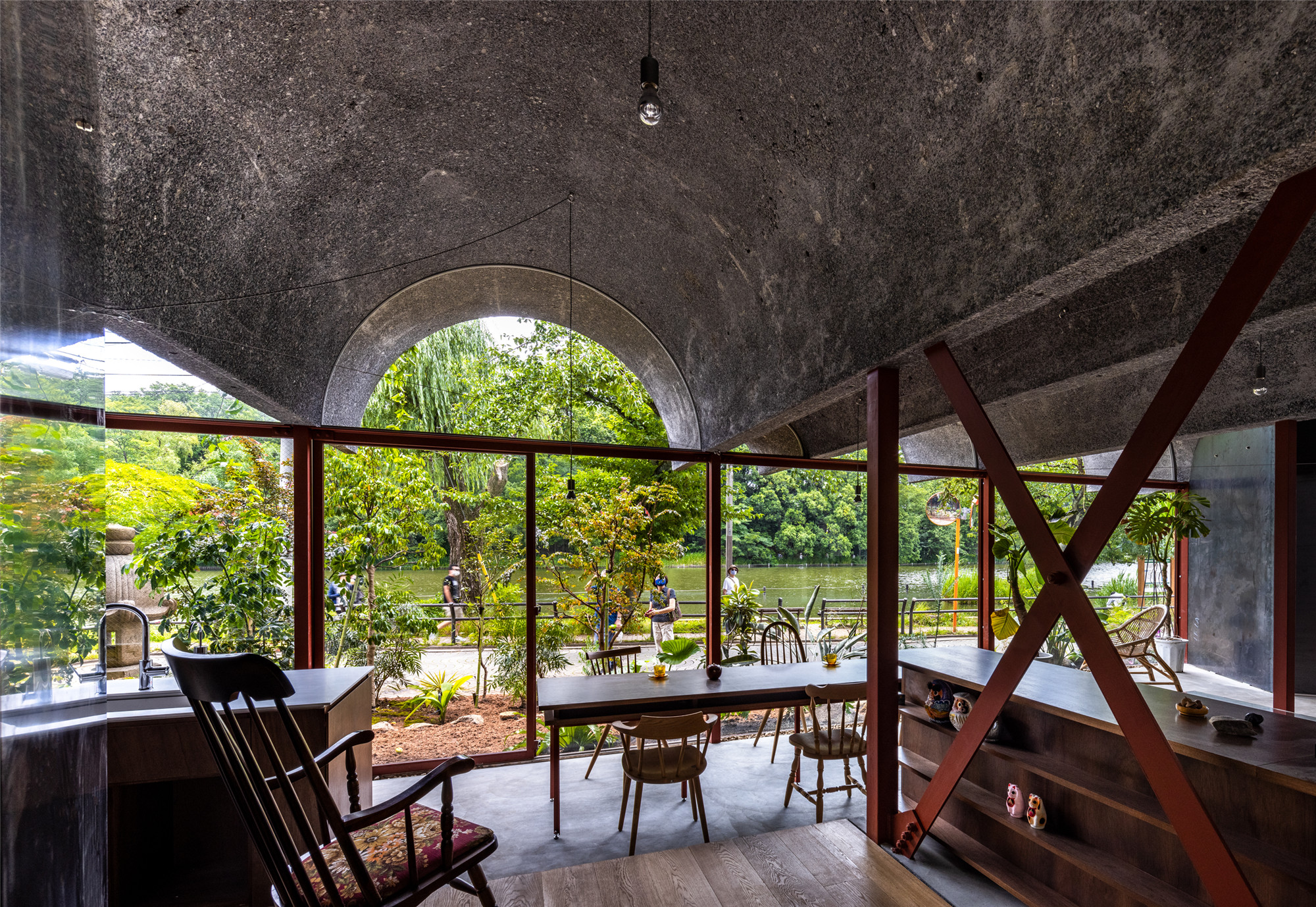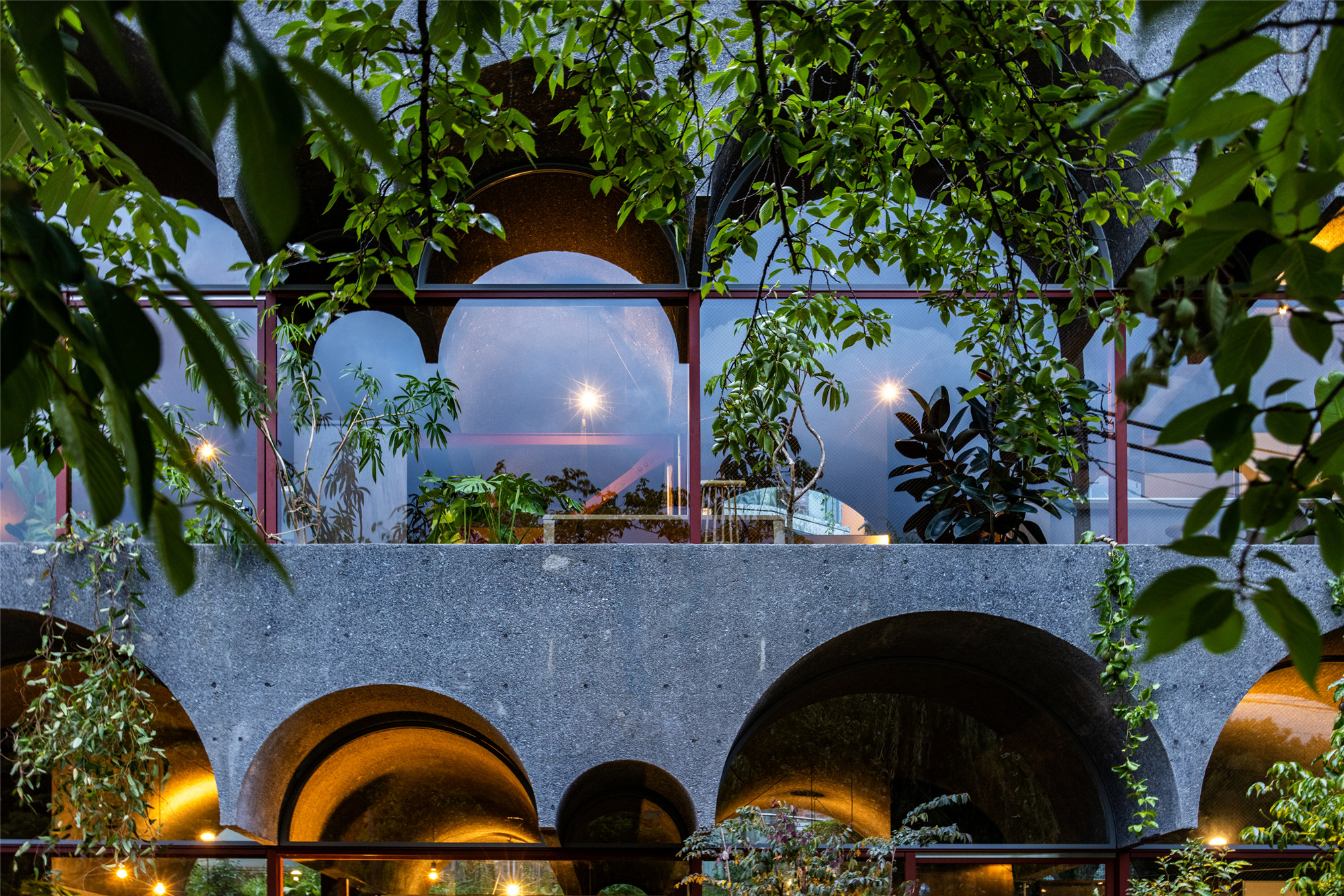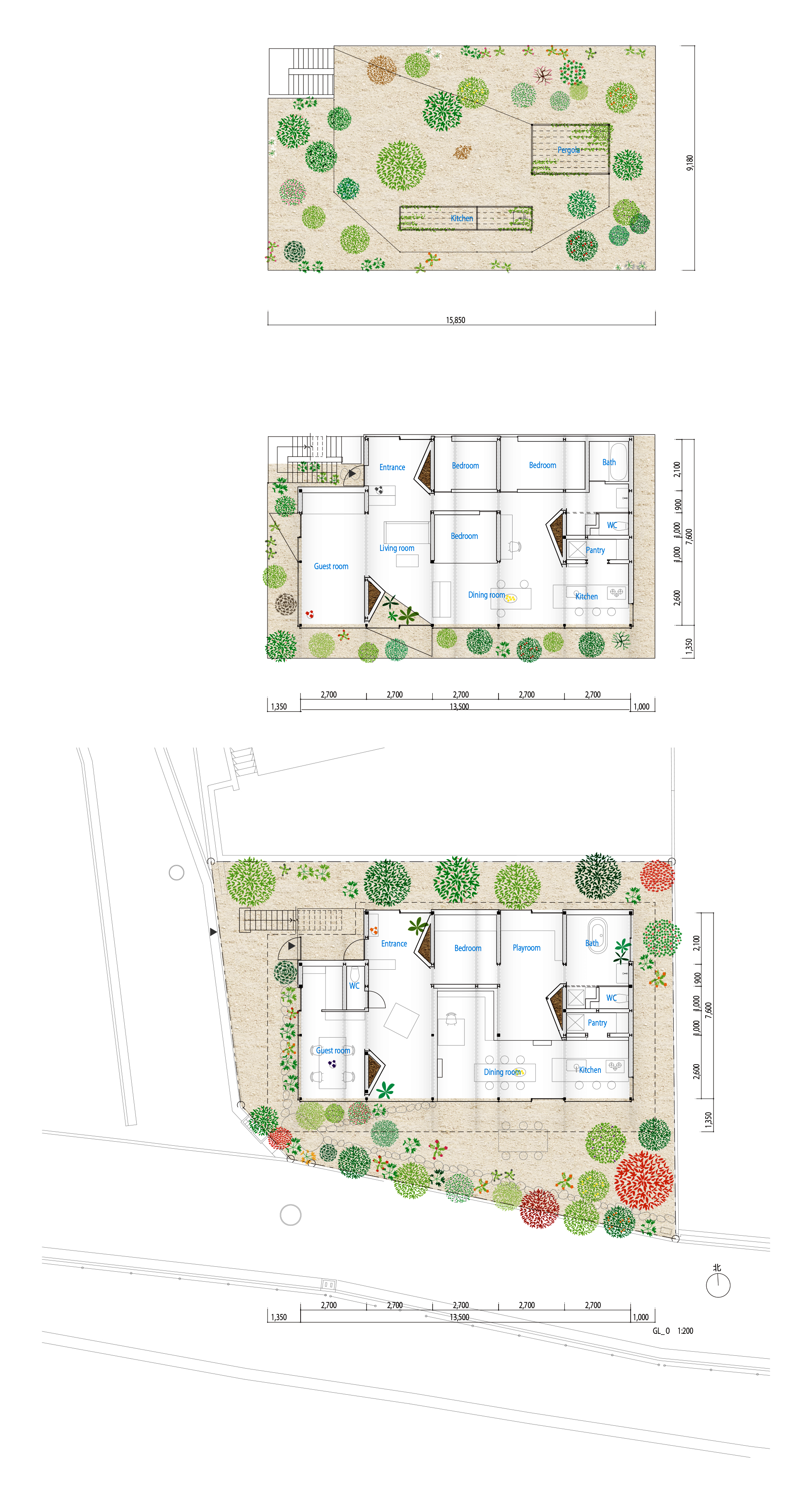
设计单位 武田清明建筑设计事务所
项目地点 日本东京
建成时间 2021年8月
建筑面积 206.72平方米
本文文字由设计单位提供。
人造制品的稳固增长
Ingrained Artefacts Growth
如今,(自然)有机体与人造制品间的平衡正处于一处交叉点。
Now, a balance between organisms and artefacts is at the crossover point.
我曾读过一篇发表于《自然》杂志上的文章,名为《人造物体质量首超活生物量》,顾名思义,就是人造物品的总质量已经超越了全球生物体的质量。此外,报道称这一趋势的主要成因为建筑材料,这也意味着截至目前, “完全为人类所服务”的建筑已经接近了一个极限。
I encountered an article published in a scientific journal titled “Global human-made mass exceeds all living biomass” (Nature: published online 9th December 2020). According to the article, human-made artefacts referred to as anthropogenic mass have begun to surpass all global living biomass. Furthermore, it is reported that the dominant cause of this trend is construction materials. This condition implies it has reached a limit to keep generating the “architecture solely for humans” produced so far.


这种情形下,建筑的作用正是人类的住所。从本质上讲,建筑的主要作用是保护自己不受自然界残酷力量的伤害。我们经历的自然灾害越多,自然与(建筑)空间之间的界限(墙)就越坚固。人类与其他生命体关于内外的分界已经愈发明显。而另一方面,人们也清楚地认识到,大自然提供的环境可能是丰富且美丽的。这就是为什么会种植花园、美化墙面和屋面的原因。
In this context, what would be the role of architecture, a humans dwelling. Essentially, the primary role of architecture is to protect itself from the brutal force of nature. The more we experience natural disasters, the more solid the wall between nature and space has become. The separation of interior and exterior for humans and other life forms has been more distinctive. On the other hand, it is understood well that the environment nature provide could be rich and beautiful. That is why gardens are planted and façade and rooftops are greened.
然而,作为装饰性或便利性景观而种植的植物,仅是从人类的角度进行规划的,它们作为人类生活空间的延伸而存在,而不是作为野生动植物的生存空间。事实上,“人造制品稳固增长”的现实成因,在于“无意识地扩大人类的空间”。
However, the plants grown as decorative and facilitated landscapes have been planned only from the human perspective. They exist as an extension of living space for humans, not as a space for wildlife. The reality of “ingrained artefacts growth” is, in fact, lies in “unconsciously expanding human space.”


所有的人类、植物、其他动物都是在地球上共生的个体,地球也是包括人类等各种生命在内的一个无形的集合。那建筑是否也可以成为一个容器,将这些生物体作为一个整体来容纳呢?
All humans, plants, animals, and insects have been co-proceeding the project “to live” on Earth. The earth is a formless assembly of various living organisms, including humans. Could architecture be a vessel to hold these organisms as one whole unit?
“鹤冈之家”就是一个试图不仅容纳人类,还要接纳其他生命形式的建筑。
“Tsuruoka House” is an architecture that attempted to hold not only people but also other life forms.

容纳环境的基础设施
Infrastructure for environment
通常情况下,场地往往在二维平面上被划分为“花园”和“房屋”两部分。然而,用这种设计方法,自然与建筑之间的关系往往只是相邻。那么,将“花园”与“房屋”在一个剖切面上相互堆叠起来会怎样呢?所有的楼层都是“地面层”,在其下提供类似于地下的空间,一种能够相互影响的关系就有可能出现了。
Usually, the site is often divided into “gardens” and “houses” in a two-dimensional plan. However, with this design method, the relationship between nature and architecture tends to be just next to each other. Then, how about stacking “gardens” and “houses” on top of each other in a cross-sectional plan. All floors would be the ground level, providing underground-ish space below them. A relationship that influences each other is likely to emerge.

土壤的厚度被设计得越深越好,如此一个“分层花园”就会成为一处小森林,承载着地被植物、灌木和较小的乔木。而现代的屋顶绿化正与其相反,追求的是更薄的土壤。这片花园通过向其他生命体开放,为它们提供栖息地,进而共创出一片“社区”,“花园”就有了“环境”的意味。
The thickness of the soil was plotted as deep as possible so that the layered garden would be a small forest hosting a mixture of ground cover plants, shrubs, and small trees. This approach goes against modern rooftop greening, which pursues thinner soli. By opening the garden to other available life forms, providing them with a place to inhabit, and co-creating the community, the “garden” becomes an “environment” .

在环境设计中,一个支持其他生命体生存的基本条件,就是土壤内清晰的雨水排放。我们在反复研究雨水受重力影响自然下落的截面关系后,得出了引入连续拱形板的设计思路。雨水从“山上”流入拱形板的“谷地”,再垂直穿过核心区。水的流向进而产生了建筑的形状。这似于一些土建工程中的做法,就如修建水渠和水坝一样,在恶劣的自然环境下保持土壤与雨水的集中。
An essential condition to design the environment to support other life forms of inhabitance was clear rainwater drainage in the soil. Following the repeated studies of the cross-section where rainwater naturally falls with gravity, a conclusion arrived at introducing continuous vault slabs. Rainwater flows from mountains to valleys of the vault slabs and is carried vertically from valleys through the core. The water flow generated the shape of the building. This approach is similar to the civil engineering design, such as irrigation channels and dams. The civil engineering design requires determined concentration in hold soil and shed rain efficiently within the harsh natural environment.



事实上,掌控一个自然环境并非易事。与静态的人造制品不同,自然环境是无法被控制的。堆积的土壤本身已经很重了,此外暴雨的重量、每年新增植物的重量都需要考虑在内。当难以预测的、不稳定的生物与气候条件成为建筑设计要求的时候,设计越是向前推进,接触到的环境因素就越复杂。
In fact, it was not easy to hold up the natural environment. Unlike static artefacts, the natural environment cannot be controlled. The compost itself is already heavy. On top of that, there are weights of torrential rains, growing and increasing plants every year that need to be considered. When unpredictable and unstable organisms and climates became requirements for architectural design, the more the design progressed, the scarier it was to embrace the environment.


即便如此,我们还是直面自然界中无法预测的风险,通过安装过流管道来解决暴雨的问题。我们还成功建立起一套“容纳环境的基础设施”,基础部分采用分层结构,在植物根系发达的上层放置高密度的保水土壤,下层放置有利于排水的低密度土壤,通过调整屋顶及室内外交界处的土壤位置来减轻房屋的自重,并利用植物的蒸腾效应减缓太阳带来的热量。
Even then, we faced unpredicted risks of nature and managed to build “infrastructure for environment” by installing over-flow pipes to cope with a downpour, designing the soil foundation with layer structure by placing high-density compost with water retention at the upper level where the plant roots can reach and positioning low-density compost with clear drainage at the lower level, and reducing the weight by limiting soil location at the rooftop and around the border of interiors and exteriors that allow transpiration to soften solar heat.



这就是集中精力来为环境创造建筑的原因。人们期待这种以环境为目的的建造,能够为人所使用的空间带来新的合理性。通过极厚的土壤包裹空间,可以塑造出一个山洞般的空间形态,这里能让人倍感凉爽,在夏季不会被外部的炎热所侵扰。在冬季,地暖系统加热土壤,在地板与建筑核心周边形成一片舒适的小场域。大地可能会对人们的生活带来积极的影响。
Why have I put my energy into creating the “architecture for environment.” It is because there was an expectation that “architecture for environment” could bring new rationality for “spaces for people.” By enveloping the space with fairly thick soil, there could be a cave-like place where you feel cooler, not feeling the heat from outside in summer. There could be a snuggly place around the floor and the core with warmed soil from the floor heating in winter. The earth may affect people’s daily life positively.




连续的拱形顶板可以遮风避雨,也形成了一些天花板较低的区域。这似乎不利于使用,但与通常平坦的顶板相比,该结构会更惹人喜爱,贴近人们的生活。天花板距地面的高度介于3.5米至2米之间,伸手就能触碰到较矮的“谷地”部分。恰因结构的可触性,螺栓、螺母、绳索等可被固定在天花之上,为悬挂吊床、吊灯和花盆提供了可能。这些结构或许能为人们激发日常生活中的创造力。建筑此刻也不单是环境的容器,更促进了人们的生活。
The continuous vault slabs formed to shed rain offers an area with a shallow ceiling height. This may seem negative at a glance, but it would be a much more beckoning structure for one’s living compared to the general flat slab. The slab fabricates a 3,500mm open high ceiling at the top, and at the valley, the height lowers to 2,000mm, reachable by hand. If the structure is reachable, eye bolts, ring nuts, and wires could be attached to plastic end cones, and it will allow us to hung hammocks, pendant lights, planters at the desired location. Reachable structures might be able to generate creativity in one’s daily life. It would be the structure to support not only the environment but also the one’s living.




与自然共生
Living with Nature
在施工过程中,一个严肃的问题仍然萦绕在我的脑海。由人造制品得到的建筑结构去容纳环境,还是通过人类的手段去“管理”自然,但环境不应该指的是“未被触及的自然”吗?
During the construction, a serious doubt still remained in my mind. The environment supported by the building structure -artefacts- is “managed nature” by human hands. However, shouldn’t the environment mean “untouched nature”?

就在我倍感疑惑之时,我回想起学生时期的一段经历。那时我在意大利乌尔比诺的一处砖石村调查废墟,其中一座废墟正座落在空旷的山顶上。走进一个原为客厅的空间,其屋顶已经破烂不堪,但令我惊讶的是房子内部居然生长着一片小树林。
When I was wondering, I remembered my experience as a student, visiting a masonry village in Urbino, Italy, for an investigation of the ruins. There was a ruin sat on the open hilltop. Entering a space that would have been a living room with a rotten holed roof, surprisingly, I found a small forest inside the room.
如果没有建筑,这里肯定只是一处长满草的山顶,但人类的建造遗迹显然丰富了这里的生物多样性。外部的石墙成为本土的常青藤向上自由生长的载体,屋顶也保护了灌木免受强烈的阳光直射,地砖为小型树木的生长积累了充沛的雨水。人造物促使环境发生改变,为多种生物的生长提供了场所。
If there was no architecture, this place must have only been a grassed hilltop. But vestige of artefacts built by humans clearly diversified a variety of organisms in this place. The external stone walls let native ivy grow vertically, the roof protected shrubs from intense sunlight, and the floor tiles held enough rainwater for small trees to survive. Artefacts generated variable qualities in the environment, providing a place for multiple organisms.



回忆起这次的经历,我重新认识到项目的最终目的——面向人类的建造,其实与面向环境并不冲突,反之也是如此。人类和自然、土壤与植物、植物与动物,通过尊重所有生命在各个方面的需求,建筑可以成为纽带,协调每一物种在环境中的作用。如果我们能建立起一种结构,促进相互之间的互补关系,也许就有可能为未来的建筑找到一个方向。
Recalling this experience, I reacknowledged my aim for the project, to present that “architecture for humans” could also be for the environment, and vice versa. Humans and nature, soil and plants, plants and animals. By respecting supply and demand among all beings in every direction, architecture could be a link to harmonise everyone’s role in existence. If we could establish a structure that fosters mutual and complemental relationships to each other, it might be possible to seek a direction for future architecture.




在“鹤冈之家”,随着时间的流逝,植物会慢慢生长,鸟类与昆虫进入其中,便引入了计划外的物种,最终就可能出现一片小的森林。几十年后,现有的生命不断生长,完全掩盖住建筑物,生物的质量最终将超过人造建筑物的质量。
At “Tsuruoka House,” over time, the plants will grow, and birds and insects will introduce unplanned species. Eventually, a small forest could appear. Then, after decades, existing life forms will grow and hide the building entirely, and ultimately, their bio-mass must surpass the mass of human-made architecture.



目前,这一座建筑还不能为全球环境的改善带来潜在的(显著)效果。但相反,这座房子它创造出一种生活,其中的人类和其他生命直接相连,并保持舒适的距离,彼此尊重,相伴相生。依托生命与人造物品间的平衡来进行延续,这就是我们简单的愿景。
Yet, this one house would not bring any potential effect to improve the global environment. But instead, to create a life in which humans and other living forms could connect directly as a you-me relationship and keep a comfortable distance to appreciate each other’s blessing within the environment sustained by an appropriate balance between organisms and artefacts, this is what I simply wanted.



完整项目信息
Project Name: Tsuruoka house
Office Name: Kiyoaki Takeda Architects
Firm Location: 3-10-12 Syakuji-cho, Nerima-ku, Tokyo, Japan 〒177-0041
Completion Year: 08/2021
Gross Built Area: 206.72㎡
Project location: Tokyo, Japan
Program: house
Lead Architects: Kiyoaki Takeda, Miyuki Sakuyama
Structural design: Akira Suzuki / ASA
Lighting design: Toshio Takeuchi
Furniture design: Sign Craft
Landscape design (plants): Acid Nature
Landscape design (gardening): Ryo Ueda
Landscape design (gardening): Echigo Kokesho
Photo Credits: Masaki hamada (kkpo)
Translation: Mami Sayo
版权声明:本文由武田清明建筑设计事务所授权发布。欢迎转发,禁止以有方编辑版本转载。
投稿邮箱:media@archiposition.com
上一篇:经典再读117 | 棉纺织协会总部:一栋房子,一座宫殿
下一篇:双层柱廊换内外开放:杭州职业技术学院学生食堂 / 浙江大学建筑设计研究院